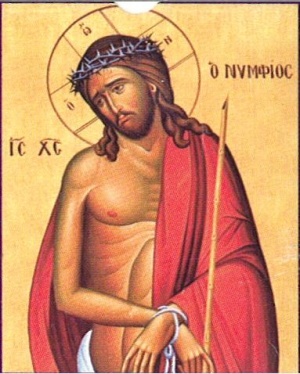Christ the Bridegroom
Christ The Bridegroom comes from the central figure in the parable of the ten Virgins (Matthew 25: 1-13); Christ is the divine Bridegroom of the Church. This title is suggestive of His divine presence and watchfulness (‘’’"Behold the Bridegroom comes in the middle of the night ..."’’’) during Holy Week.
The Bridegroom is also the name given to the central icon used in The Service of the Bridegroom. The Bridegroom icon and service has been more commonly known as "O Nymphios" but over the last decade, this title has caused much confusion to the ever-growing English speaking christian population.
Contents
Service of the Bridegroom
The Service of the Bridegroom is an Orthros type service specific to the first three evenings of Holy Week and commemorates the last days in the earthly life of our Lord. They were sorrowful days because the purpose of the evil was to dispose of Jesus and rid His message for ever. The icon of Christ the Bridegroom is brought into the church wearing a crown of thorns and it remains in the church until Holy Thursday. In the services we read and chant hymns telling us about the beginning of the passion and anticipate His crucifixion and resurrection (or “Marriage” to the “Church”) – releasing of the passage from death to life. Each night, we sing the Hymn to the Bridegroom and the vestments of the Priest and the altar clothes are black or deep purple to symbolise and create the atmosphere of mourning and remembrance of the great shame of the Fall of Adam and Eve, the depths of hell, the lost Paradise and the absence of God. The main emphasis of the Bridegroom Serve is metanoia and each service has its own particular theme.
Palm Sunday evening
At the service of Palm Sunday evening, the priest carries the icon of Christ the Bridegroom in procession, and we sing the "Hymn of the Bridegroom." We behold Christ as the Bridegroom of the Church, bearing the marks of His suffering, yet preparing a marriage Feast for us in God's Kingdom.
- The Bridegroom icon
- The icon depicts Jesus dressed according to the mockery of the Roman guards just prior to his crucifixion.
- The crowns - The crown of thorns are a symbol of His marriage to the church.
- The rope - the rope symbolise our sins. When we do not repent or confess our sins, we tie Christ's hands from being able to help us in our salvation.
- The reid - a symbol of His humility; God rules his kingdom with humility.
- The Hymn of the Bridegroom
- Behold, the Bridegroom cometh in the middle of the night, and blessed is that servant whom He shall find watching; and again unworthy is he ...
Holy Monday evening
On Holy Monday, the Blessed Joseph, the son of Jacob the Patriarch, is commemorated because he is seen as a prototype of Christ.
Joseph was betrayed by his brothers, thrown into a pit and sold into slavery by them. In the same way, our Lord was rejected, betrayed by His own, and sold into the slavery of death.
The Gospel reading for the day is The Barren Fig Tree, which Christ cursed and withered because it bore no fruit. The fig tree is a parable of those who have heard God's word, but who fail to bear the fruit of obedience. Originally the withering of the fig tree was a testimony against those Jews who rejected God's word and His Messiah. However, it is also a warning to all people, in all times, of the importance of not only hearing the God's word, but putting it into action.
Holy Tuesday evening
On Holy Tuesday, the Parable of the Ten Virgins is read. It tells the story of the five virgins who filled their lamps in preparation for receiving the bridegroom while the other five allowed their lamps to go out and hence were shut out of the marriage feast. This parable is a warning that we must always be prepared to receive our Lord when He comes again. The theme of the day is reinforced by the expostelarion hymn we sing "I see Thy Bridal Chamber adorned, O my Savior, but have no wedding garment that I may enter. O Giver of Light, enlighten the vesture of my soul, and save me."
We also remember Kassiani (September 7). Kassiani was a beautiful young aristocrat, who came from a Byzantium family at the time of the Emperor Theophilos (9th century). While choosing a bride from a parade of eligible girls, Theophilos became angry at a reply Kassiani gave as a reply to a question of his, so he impulsively chose Theodora, who was standing next to Kassiani, as his bride. Kassiani played a great role in the restoration of the Holy Icons and dedicated her life to the composition of sacred poetry. Heartbroken by Theophilos, one of those poems was this beautiful hymn. It retains the original Byzantine music which may be difficult for all to understand. Theophelos, searched for Kassiani and found her at a convent and the two never saw each other again. Her repentance and love for Christ is the theme of the wonderful "Hymn of Kassiani" which is chanted on this night, reminding us one more time, before "it is too late," that we too may be forgiven if we repent.
